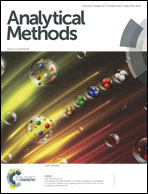Ultrasensitive detection based on gold nanoparticles for the platelet-associated tissue factor in patients with thrombotic diseases†
Abstract
The platelet-associated tissue factor (TF) is a physiological index related closely to thrombotic diseases discovered recently. A novel plasmonic enzyme-linked immunosorbent assay (ELISA) strategy has been developed for colorimetric amplification detection of the platelet-associated TF in this report. The detection mechanism is based on the fact that acetylcholinesterase (AChE) can catalyze acetylthiocholine chloride (ATC) to produce thiocholine which can cause the aggregation of gold nanoparticles (AuNPs) through forming Au–S bonds, and thus control the color and absorption spectra changes of AuNPs. This approach gave a detection limit narrowed down to 10−14 g mL−1, a value that is much lower than that of conventional ELISA procedures. The results of plasmonic ELISA in platelet-associated TF assays of blood specimens from 40 patients revealed that this assay can be used for the quantitative detection of the platelet-associated TF in human blood. This method provided a valuable tool for the ultrasensitive detection of the platelet-associated TF that shows potential for diagnosis and therapeutic monitoring of thrombotic diseases.


 Please wait while we load your content...
Please wait while we load your content...